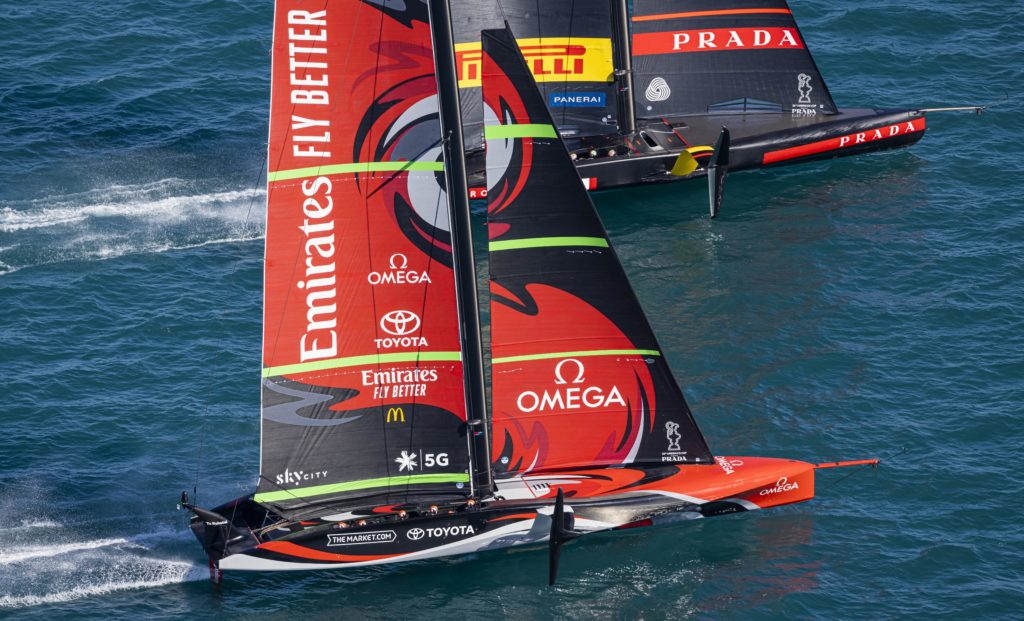
On the morning of the 36th America’s Cup Match, the regatta that two sailing teams have been completely committed to is now suddenly upon them. Around the bases and to reporters, the sailors talk of the three-year commitment, of the confidence in their multimillion-dollar 75-foilers, and of boatspeed. Boatspeed is king. But yesterday, what they spoke of most was putting an end to the talking and getting on with the races. It’s time to let the results speak for themselves.
With the opening races delayed by four days following the reappearance of COVID in the streets of Auckland, the pandemic-driven pause has contributed to a sublime but elevated anxiety along the waterfront. The longer the sailors have been forced to wait the shorter the racing calendar has become. With two critical races per day in the best-of-13 series there are no large gaps in the schedule for either team to overcome a major technical failure or a destructive capsize the likes that the New York YC’s American Magic suffered in the Prada Cup Semifinals.
Racing starts at 4:15 this afternoon, March 10, in New Zealand when Defender Emirates Team New Zealand and its Challenger of Record, Luna Rossa Prada Pirelli Team, will point their bows at each other and enter the starting box for the Match’s first encounter. As a result of a draw, Emirates has port entry in the first race, which makes them the rabbit to the Italian fox.
Which team has the better starting helmsman (or helmsmen, if that be the case for either team) is not what matters because they’re each supremely talented and practiced. Peter Burling, Glen Ashby, Jimmy Spithill and Francesco Bruni…each and every one of them are capable of whipping their respective AC75s around the racetrack and keeping their target speeds on target. As they have from the outset of Cup racing, Spithill and Bruni share helming roles 50-50. It’s more dynamic on the New Zealand boat, says Burling. Sometimes they have crew changing sides, sometimes they don’t. It depends on the maneuver or the time and place on the racecourse.
Yes, match racing is the name of the game, and even though their closing speeds are frighteningly fast, the pre-start moves and countermoves have been thoroughly explored in each team’s simulator and 24/7 recon. With a confined starting box, only 2 minutes to burn, and a finite amount of input from the grinders, there’s not much either can do. The obvious pattern of the Prada Cup races was that the port-entry boat has essentially on big maneuver before making a run for the line; the starboard entry boat has two. Burling and Spithill have clear expectations of what the other is—is not capable of—and how to exploit it.
Burling, a master of the press-conference question dodge, tells us we’ll have to wait and see which team has the better package and who will have the better of the starts. And the better start, he says, doesn’t necessarily mean winning the favored end.
Burling, a master of the press-conference question dodge, tells us we’ll have to wait and see which team has the better package and who will have the better of the starts. And the better start, he says, doesn’t necessarily mean winning the favored end. Like any sailboat race, the first 30 seconds of the first leg will dictate who controls the race. Those 30 seconds are all about boatspeed, he says. “The person with the best speed off the line generally does better out of the boundary,” he says. “It’s really about making sure you have good gauge and speed.” Starting to windward or leeward doesn’t matter. “Either way works.”
What happens then on the open racecourse is impossible to predict given the “dynamic” forecast for the series, says Burling, acknowledging that Luna Rossa is fast in straight line and do their maneuvers without much loss. Max Sirena, the Italian squad’s skipper and motivator-in-chief, was more measured in his response at the press conference, pointing out several times that he has no crystal ball, but what he does know his sailing team will give it their all. It’s been 20 years coming.
“Now we can really say that we are in the America’s Cup,” Siren says. “It’s been a long journey to reach this point, with pitfalls and tough moments. It is an important moment for us and represents the result of three years of hard work. We have proved that we would not give up, even when everyone had signed us off. The whole team is fully focused on racing. We’re ready to give our very best without forgetting our final goal and why we are here. It’s obvious that when you are in an America’s Cup final anything can happen, it’s not just any regatta, you are up against the best and to beat the best you have to do better than them.”
“We know they are fast,” Sirena said in the press conference, describing the New Zealand boat as one custom-tailored for Burling’s fearless sailing style, honed on the Olympic 49er and pretty much anything on foils these days. [Emirates Team New Zealand’s boat] represents Pete,” Sirena said. “He’s sailing at the edge all the time.”
Boatspeed. It will be the word of the match—as it has been for the entirety of America’s Cup history—but this time especially, if one boat is even just marginally faster, there’s a strong chance for a whitewash. As happened in the Prada Cup semi and final races, the Cup’s narrow racecourse and 25-minute races don’t offer much when it comes to passing opportunities. The action will be fast and furious, but the principles of Cup racing remain firm: with flawless maneuvers, one must get ahead and stay ahead. And don’t break the boat.









